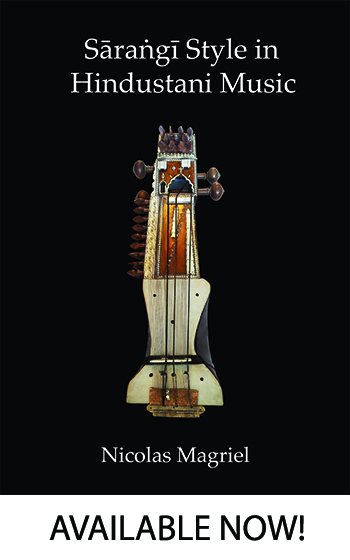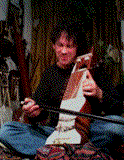
Bapu Lal Shishodiya (1934-?) was a lovely warmhearted sarangi player whom I first met in 1977 when I was learning from the great vocalist Dilip Chandra Vedi. Bapulalji walked barefoot into Vediji's class at the Bharatiya Kala Kendra in New Delhi, apparently having just arrived from his village in the Mandsaur district of Madhya Pradesh, looking for work. With Vediji's help he secured a job as an accompanist at Birju Maharaj's Kathak Kendra—just down the road on the Mandi House traffic rotary. In the nineties I interviewed and filmed Bapulalji at home in Lakshmi Nagar, Delhi, across the Yamuna river with his sons Madan Lal (tabla) and Gana Shyam (sarangi)—who many years later, grown up, featured importantly in my Growing into Music work, teaching their own children.
Bapu Lal Shishodiya came from Parli, a village in the Malvi district of Madhya Pradesh. His father Ram Lal was a tabla player, so Bapu Lalji learned sarangi from his uncle Hardiyal, his grandfather Pura Lal, and his great uncle Bhavani Prasad. Bapu Lalji learnt singing from the age of ten, and then took up sarangi when he was twelve.
My first upload is of my first visit to Bapulalji's house, March 5, 1994. We start with a beautiful thumri in Pilu accompanied on tabla my Madan Lal who demonstrated his excellence on tabla in the concluding laggi:
Then he played khayal in the afternoon rag Madhuvanti:
Due to a tape problem, only the end of a drut khayal rendition of the evening rag Puriya Kalyan:
Finally a dhun in rag Pahadi:
Then Bapu Lalji talked about various subjects:
I visited Bapu Lalji again on the 20th of May, 1997. Gana Shyam's playing had come a long way. Our first video is a long session of father and som tuning their sarangis:
Then they treated me to a beautiful rendition of the morning rag Ahir Bhairav, including a gorgeous bandish that I recognised from the singing of Amir Khan:
Then they midday rag Shuddh Sarang:
Then Gana Shyam switched to providing table accompaniment—very proficiently. Bapu Lal played a short rendition of rag Suha:
Then the creepy (to my ears) rag Madhukauns:
Followed by a lyrical dhun in Pahadi:
Then a beautiful Bhairavi thumri:
Our last video begins with the rare rag Kaushikranjani in a difficult 11-matra tal. This eventually gives way to the more standard 10-count jhaptal. Bapulalji finished with a fast rendition of Brindabani Sarang:



